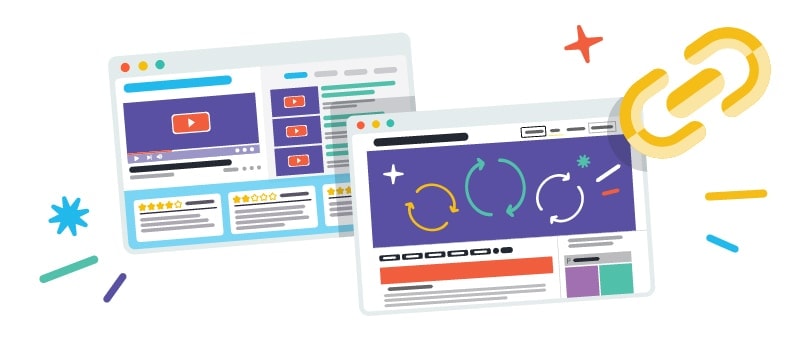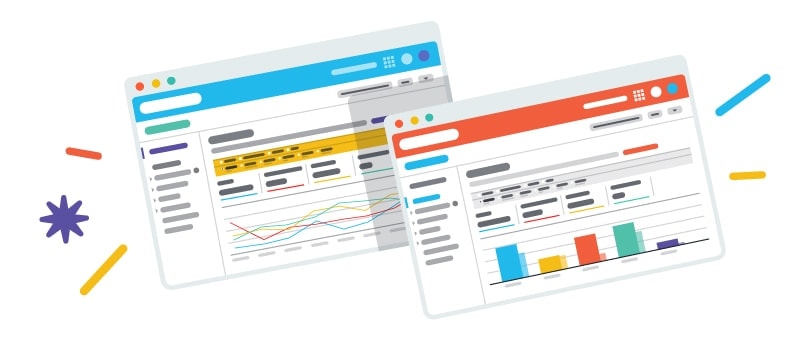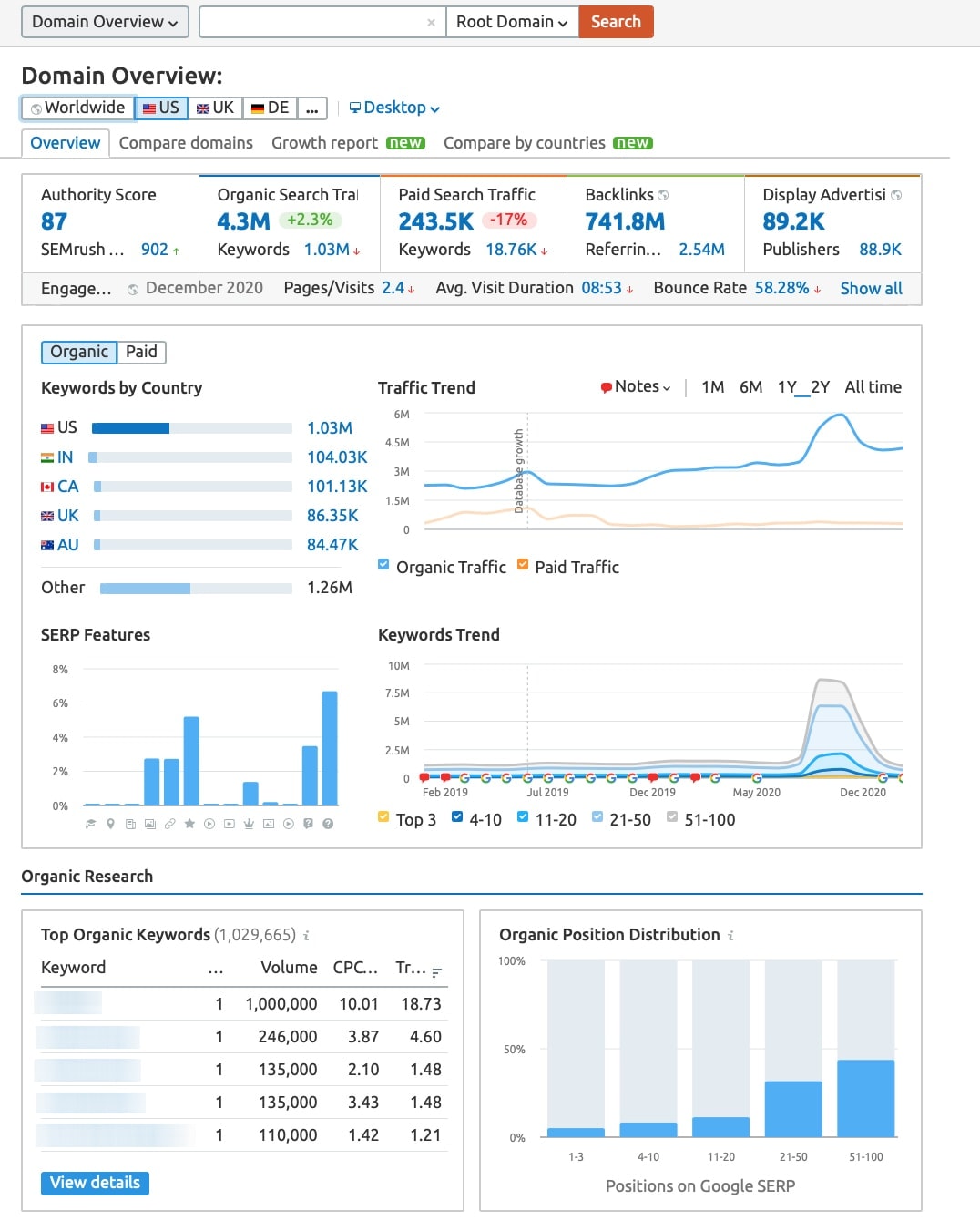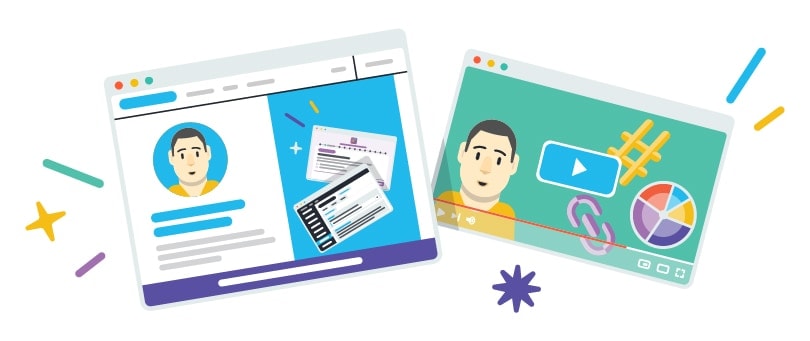
Ecommerce SEO Strategies to Get Your Online Store in the SERPs
SEO is a huge topic: Hugely important for website owners, and hugely daunting for those unfamiliar with it. If you’re new to SEO optimization or don’t know what steps to take with beginner SEO or ecommerce SEO, this post is for you. If you’re looking for advanced SEO strategies, you’ll find some of those in this post, too! There’s something for everyone in this SEO article.
Our main goal here is to help website owners and ecommerce store merchants understand what SEO is, how to use SEO, and what kind of ecommerce SEO strategies they can and should use on their site.
But, before we get started, it’s important for us to point out that SEO is a long-term commitment. It’s a marathon, not a sprint. There are strategies, but there are no shortcuts. You can’t buy your way to the top—you have to consistently implement SEO tactics and best practices and hope they pay off in the long run.
You can’t buy your way to the top—you have to consistently implement SEO tactics and best practices and hope they pay off in the long run.
However, using the tips and strategies in this guide, your SEO should pay off.
In this guide, we’ve included some SEO tactics that are basic website hygiene practices all sites should implement, plus some other important SEO strategies that will give you a leg up on your competition.
But—don’t underestimate these SEO strategies! Some might seem boring or too long-game, while others might seem too insignificant to move the needle, but that’s the thing with SEO—after you’ve implemented all the basics, sometimes it just takes small additional adjustments to give you an edge over your competitors that helps drive you up in the SERPs!
Overall, SEO is something that compounds, and the little things contribute just as much as the big things. So, if you want to improve your SEO, it’s worth trying out everything in this guide to see what works and doesn’t work for your site.
With all that said, let’s jump into this ultimate guide to SEO!
Table of Contents
- What is SEO
- Why is SEO Important
- Should You Hire Someone for Your SEO?
- How Does SEO Work?
- Why Do I Need SEO?
- On-Site SEO vs. Off-Site SEO
- SEO Strategies to Get Your Online Store in the SERPs
- Keyword Research for SEO
- On-Site SEO Tactics
- Off-Site SEO Tactics
- How to Track Your SEO Progress
- SEO Tools
- SEO Courses
- Short SEO Checklist
What is SEO?

SEO stands for Search Engine Optimization and is the act of making a website or online store appealing for search engines like Google to recognize, crawl, and categorize for the purpose of showing up in search engine results.
SEO is a strategy that website owners or online store merchants use to get more visitors to their websites. Getting more website visitors usually equates to getting more customers, which means earning more revenue and profit—so optimizing for SEO can actually be really lucrative and thus, worthwhile.
However, SEO takes time to build up. It’s a slow process to get recognized by search engines—so think of it more like a marathon than a sprint.
The Three Types of SEO
In general, there are three types of SEO: White-hat SEO, Grey-hat SEO, and Black-hat SEO:
- White-Hat SEO: White-hat SEO is used to define completely legitimate SEO tactics that follow Google’s rules and suggestions basically to the letter. Using white-hat SEO techniques is the proper way to get your site ranked in search engines, but it also requires a lot of time, work, networking, and relationship-building. Ultimately, this is the type of SEO you should use on your website as it will be the safest in the long run (grey- or black-hat techniques put your website at risk of being de-indexed by search engines) and yield the best results.
- Grey-Hat SEO: Grey-hat SEO is used to define SEO techniques that are a mixture between following the rules and bending them slightly. They include taking some shortcuts that search engines may not advise, but don’t tend to penalize either. You shouldn’t rely on grey-hat SEO techniques for your website, but they can sometimes be used cautiously, ethically, and in small amounts to add a little oomph into white-hat SEO techniques.
- Black-Hat SEO: Black-hat SEO is used to define the SEO underworld. Here, software can be used to spin hundreds of versions of blog articles, blast them to automated websites, create thousands of social links on automated accounts, and mine spammy backlinks. The purpose of black-hat SEO is to get sites ranked on search engines quickly—but it’s very likely that search engines will notice the black-hat techniques and de-index the websites just as fast. Black-hat SEO techniques are usually used by churn-and-burn sites (sites that are set up to make money fast with the knowledge that they’ll likely get de-indexed quickly) but they’re not effective, ethical, or recommended techniques to rank a long-lasting website.
Every SEO tactic or technique we cover in this post is white-hat SEO.
Why is SEO Important?

SEO is important because it can bring massive amounts of relevant traffic to a website. It means that if you’re a website owner, you just have to implement SEO techniques once and you’ll reap the rewards day after day, month after month, and sometimes year after year. Done well, SEO can be one of the main drivers of traffic to your website—and it’s free!
This differs from most other marketing channels which stop delivering traffic the second you stop paying. Although SEO is a little bit trickier to implement than paid marketing channels and it will take more time to reap the rewards, the results can often be better and more consistent over a longer period of time.
Plus, implementing SEO practices is just good website hygiene. The techniques are often simple enough to carry out—it’s just a matter of doing them consistently, thoroughly, and smartly—but every website should keep up with their SEO to maintain their website’s overall health. SEO is to your website what a healthy diet and exercise is for you: It might not seem like it’s doing much day-to-day, but it adds up in the long run and you’ll thank yourself later for being consistent with it as early on as possible.
SEO is to your website what a healthy diet and exercise is for you: It might not seem like it’s doing much day-to-day, but it adds up in the long run and you’ll thank yourself later for being consistent with it as early on as possible.
Overall, SEO can be one of the biggest sources of traffic to your website, and although it takes some work and time to get it up and running, it will be worth it in the end when you don’t have to pay to get visitors landing on your site. And, it’s just a best practice all websites should have.
Should You Hire Someone for Your SEO?

Inevitably, at some point in your website’s lifetime, you’ll either be contacted by a freelancer or agency to improve your SEO, or you’ll think about hiring a freelancer or agency to improve your SEO.
So… Should you?
While there are a lot of great people out there who can likely help you, a major problem exists in hiring someone to do SEO work for you.
SEO, by nature, takes time. It can take weeks, months, or longer to show any signs of success. When paying someone to optimize your website’s SEO, they might feel pressured to produce results to show you that they’re working and doing a good job. In order to show results faster though, corners might get cut and not-so-legitimate methods might be used (such as grey-hat or black-hat SEO techniques).
As search engines like Google discover and crack down on grey-hat and black-hat SEO methods, you may lose the results you’ve gained, and Google may even penalize you by bumping you to the bottom of the search engine ranking positions (SERPs) or stop indexing you altogether.
This can be potentially catastrophic for your website, as it can drastically reduce your traffic overnight, with no warning.
So, as a new small business and website, we can’t stress enough the importance of learning SEO yourself. Not only will it be beneficial for you to know how and where to implement SEO tactics, but it can also help prevent anyone from causing any kind of catastrophic SEO-related event that jeopardizes your website or livelihood.
The only situation that would change our minds about this is if you already know how to do SEO yourself. This way, you can keep an eye out for grey-hat and black-hat SEO techniques and ensure none are ever used on your site.
How Does SEO Work?

Are you confused about what SEO is and how it works? Let us break it down for you.
There are 4 main players involved in SEO:
- The websites/blogs/online businesses
- Search engines (like Google, for example)
- The searchers (who use search engines like Google to find websites)
- Google’s algorithm (which is mostly unknown and always changing)
And here’s a breakdown of how SEO works:
- People go to search engines (like Google) to find websites, blog posts, or online stores.
- Search engines (like Google) want to be helpful and show searchers the most relevant results for whatever they’re searching for.
- In order to do this, Google has a formula (also known as an algorithm) that helps them determine which results are relevant to which searchers.
- They use robots to “crawl” websites to find special indicators that let them know what the website is about, so they know which searchers to show the website to.
- Because Google doesn’t want their algorithm to be taken advantage of, they don’t always make it obvious what special indicators they look out for. If they did, there are some people who would likely take advantage of that information and use it for nefarious purposes (as in, they’d spam the process).
- So, people who have websites, blogs, or online stores know they need to appease the algorithm in order to be shown as a Google search result—but they don’t know exactly what kind of special indicators (AKA, SEO techniques) they need to use on their websites and where.
- Plus, search engines like Google are always changing the SEO techniques they look out for, because they’re always making updates to improve the search results for their searchers.
- Luckily, over time, website owners have figured out some of the main SEO tactics that all websites should have so search engines like Google recognize them and show them to searchers.
- When these tactics are used, it means that searchers will be able to find your website more easily, which means that you’ll have more people landing on your site, and hopefully, purchasing your products.
Why Do I Need SEO?

It’s simple—you need SEO if:
- You want your site to be easily discoverable by searchers on search engines like Google
- You want traffic coming to your website easily and without having to pay for it
- You want traffic coming to your site consistently
- You want to be competitive against your competitors, who are likely also using SEO
- You want to keep your website in its best condition
As a basic rule of thumb, all websites need SEO.
If you’re using white-hat SEO, there’s virtually no downside to optimizing your website, so it should not be avoided. Plus, it’s pretty simple to do, you just need to learn what to do and keep it consistent over time. The benefits outweigh any kind of negatives, so if you have a website, blog, or online store, you should be implementing SEO—no questions asked.
The benefits outweigh any kind of negatives, so if you have a website, blog, or online store, you should be implementing SEO—no questions asked.
On-Site SEO vs. Off-Site SEO

There are two types of SEO:
- On-Site SEO: This includes all of the SEO tactics you have direct control over. These are things you can do on your own site to help search engines better understand what your site as a whole is about, plus what each individual webpage and product page is about.
- Off-Site SEO: This includes all of the SEO tactics that you don’t have direct control over. These things are usually signals from other websites that show search engines that your website is being vouched for and that others get value from it. These things can’t just be added to your website, you have to hope other websites support your site, or ask other websites to do these things for you.
The differences between these two types of SEO are important, so we’ll be categorizing the SEO tactics down below into On-Site SEO and Off-Site SEO categories so you can differentiate between the two.
SEO Strategies to Get Your Online Store in the SERPs

It’s time to get into all of the SEO tactics you can use to optimize your website for search engines.
But, before we jump into the On-Site and Off-Site SEO tactics, there’s just one more thing.
A major component of any SEO strategy is keyword research. Without any keyword research, you won’t know what you’re optimizing for search engines, and without any keyword optimization, you probably won’t get very far in the SERPs. Keyword research is the foundation upon which SEO optimization is built.
Keyword research is the foundation upon which SEO optimization is built.
So, you need to have an understanding of what keywords are and how they’re used so you can use them to SEO optimize your site.
But—the good news is that keywords and keyword research are easy to understand! You can check out our Guide to Keyword Research to get the full picture as to what keywords are, why they’re important, how they’re used, and how you can research keywords for yourself. But if you want the short version, we’ll break it down below.
Keyword Research for SEO

First things first.
You need to choose the right keywords. Not only for your site as a whole, but also for each individual webpage and product listing.
What is a Keyword?
A keyword is a word or phrase that people search for online to find what they’re looking for.
Keywords are typed into search engines like Google, and when the user clicks on the “Search” button, Google shows a list of search results to the user based on what it thinks will be the most relevant results related to the keyword (or keywords) they searched.
Examples of keywords include:
- Digital Marketing
- World Cup
- Best Hiking Trails
- Top Travel Destinations
- SEO
- Ecommerce
Why Do You Need Keywords for SEO?
Keyword research is the first step in the ecommerce SEO process.
Why?
Because without the right keywords, you won’t be able to optimize your website or your product pages for search engines.
With the right keywords, you have the ability to push your site to the first page of Google and bring in hundreds—or even thousands—of pageviews week after week.
Which Keywords Should You Use?
There are several different ways to categorize keywords, and one of those ways is by their length.
Short-tail keywords are keywords that are two words or less. This also includes abbreviations like, “SEO.” Long-tail keywords are keywords that are longer than two words but are usually no more than four or five words. Long-tail keywords can also be referred to as “key phrases.”
Examples of short-tail keywords are:
- Ecommerce
- Notebooks
- Digital Marketing
- Golf Courses
- Chairs
Examples of long-tail keywords are:
- Best Ecommerce Conferences
- Notebooks for Teachers
- Digital Marketing Tools
- Top Scottish Golf Courses
- Ergonomic Office Chairs
The difference between short-tail and long-tail keywords (besides the fact that long-tail keywords are obviously longer) is that long-tail keywords are usually easier to rank for. This plays an important role in the keyword research that you’ll do for your own site’s SEO because it means that you’ll usually be on the lookout for long-tail keywords.
In addition to categorizing keywords by being short-tail or long-tail, you can also categorize keywords by the searcher’s intention.
The different types of search intent are as follows:
- Informational Intent: This is when searchers are looking for information. An example keyword with informational intent is, “Best keywords to target.”
- Navigational Intent: This is when searchers are looking to get somewhere online. An example keyword with navigational intent is, “Keyword research tools.”
- Commercial Intent: This is when searchers are looking to buy something. An example keyword with purchase intent is, “T-shirts with digital marketing slogans.”
It’s important to optimize the right parts of your website with keywords that correspond to the appropriate searcher intent so users find what they’re looking for when they land on your site.
If they don’t, they’ll likely bounce away, which can have a negative impact on your SEO.
What is Keyword Optimization?
Keyword optimization is the act of perfecting the use of keywords on your website, webpages, product pages, or blog posts so that you can rank in Google search results for them.
In other words, it means knowing what keywords to use, where to use them, when to use them, how often to use them, and then actually using them.
How Do You Do Keyword Research?
Now that you understand more about keywords and keyword research, the next step is to actually choose which keywords to target.
The best way to narrow keywords down is based on these four criteria:
- Search Volume
- Keyword/Product Fit
- Commercial Intent
- Difficulty/Competition
You can find out this information for each keyword by using a keyword research tool. Our preferred keyword research tool is KWFinder (KWFinder Review) because it’s sophisticated and thorough while being easy to understand. In our opinion, KWFinder offers the best value when you consider the cost as well as the services offered.
Another keyword research tool is the Google Keyword Planner, however, we’ve found it to be hit or miss. It allows you to search for and find keywords but it tends to focus on the level of competition for keywords in terms of paid search marketing, not organically through SEO. GKP is free though, so that’s a bonus.
A third option that’s super powerful and has a ton of different features is SEMrush. SEMrush is a web-based tool that makes finding the best keywords for your site/store super easy. In fact, it’s kind of like stealing candy from a baby—if candy = traffic, and a baby = your competitors. It’s high value, so it’s worth pursuing if you’re really serious about keyword research for your SEO, but keep in mind that it has a premium price tag to match.
Check out our Guide to Keyword Research for more free and premium keyword research tools you can use to find keywords.
On-Site SEO Tactics

Once you’ve nailed down your keywords, it’s time to put them to use on your site. You can do that with these on-site SEO tactics.
These are the SEO tactics that you have control over. You can make these changes to your website or ecommerce store at any time, and in doing so, you’ll be optimizing your site in a way that makes it more appealing to search engines.
Let’s get into it.
Optimize Your Meta Title & Meta Descriptions
No matter where you’ve set up your website—whether it’s on Shopify or WordPress or BigCommerce or wherever—you should have the ability to edit the meta title and meta description for each page of your site.
- What’s a meta title? It’s the title of your website or webpage that shows up in search engine results. You know when you search on Google and the list of results comes up? The title of each result is its meta title. Meta titles should usually be 50-60 characters or less. You don’t want to go over the character limit otherwise searchers won’t be able to read your full title.
- What’s a meta description? It’s the description of your website or webpage that shows up in search engine results. Under every meta title in search results is the meta description. Meta descriptions should be anywhere from 150-160 characters. You don’t want to go under the character limit because it won’t be enough information for the search engine or for the readers, and you don’t want to go over the limit either as searchers won’t be able to read the full description.
You have the option to create a custom meta title for each page of your website (whether it be your homepage, your product pages, your blog post pages, etc.) and you should optimize them with keywords to make them more SEO-friendly.
Tips for optimizing meta titles and descriptions:
- Use Keywords at the Beginning of the Meta Title: Ideally, your keywords(s) should start off the title. The closer your keyword is to the beginning of the title, the more weight search engines will give to it. But don’t compromise on the integrity of your title—you want to think about the reader first and if the title makes sense to them; optimization comes second.
- Use No More than Two Keywords in the Description: Use your keyword at least once in the description, and again, as close as you can get it to the beginning, the better. If you can create an opportunity to mention your keyword a second time in the description, then go for it. But again, remember to ensure that the description reads well for the reader first, and for SEO optimization second. And ideally, don’t use your keyword more than twice. Any more than that and it could seem spammy.
Optimize H Tags
Every page on your website (including your homepage, product pages, and blog posts) should use H Tags. These are “heading tags” that break your page content into headers. H Tags start with H1, which should be the title of your page; followed by H2, which should be subheadings; H3 should be used for less-important subheadings; same with H4, and so on.
Breaking your content up by headings not only makes it easy for your readers to navigate the page, but it makes it easy for search engines to navigate the page, too.
Plus, make sure to use your keywords in your H Tags too, especially H1 and H2 Tags as those carry the most weight.
Optimize the Introduction Paragraph
Use your main keyword in the first sentence and/or paragraph of your website page, blog post, or product description. Again, the closer your keyword is to the beginning of the page, the more emphasis search engines will put on it.
Improve Your Site Load Speed
How quickly your site loads plays an important role in your SEO, and you have the power to make it faster if it’s loading slowly.
A widely quoted study found that 57% of consumers leave a website after just three seconds if it’s slow to load. Not only that but if a page loads within two seconds, it only has a bounce rate of 2%, whereas if the same page takes five seconds, the bounce rate increases to 38%
When visitors click away from your website quickly (otherwise known as “bouncing”), it indicates to search engines that your website or store isn’t providing searchers with value, so your site might not get recommended in search results often, or at all.
To improve your site’s loading speed, you can do a few things:
- Reduce the File Size of Images: Optimize all of your images so they take less time to load. This can shave seconds of time off your site’s loading speed which can equate to keeping a much larger percentage of visitors. Use tools like ImageOptim and ShortPixel to do this.
- Host Videos Off Your Website: Hosting videos on your own site weighs it down, so keep videos hosted on platforms like YouTube and just share the embed link on your site.
- Keep Your Code Clean: Too much extra code on the backend can bog down your site, so keep it clean. If you don’t know how to edit your site’s code, then don’t worry about it. But if you are adding code, make sure to narrow it down to what’s necessary.
- Don’t Add Too Many Apps or Plugins: Connecting your site to different apps and plugins adds extra weight, so only integrate with apps and plugins that are really important. Bloating your site with apps and plugins you don’t use won’t help your site’s loading time.
In general, the more things your site has to reach out to, connect to, or load up will impact how long it takes to get your site up and running for a visitor, so keep that in the back of your mind every time you add something to your site.
For more tips on how to minimize your site’s bounce rate in general, check out our How to Minimize Your Store’s Bounce Rate article.
Optimize the Page Slug
What’s a “slug?”
It’s the part of a URL that comes after the main body of the URL’s domain. For example:
www.abetterlemonadestand.com/this-is-the-slug
When you create a new webpage, product page, or blog post page, your slug will be automatically created for you, but instead of using whatever’s generated, change it to your primary keyword.
For example, check out the slug for this blog post:
www.abetterlemonadestand.com/ecommerce-SEO
Best practices for slugs are to keep them short, use your target keyword, use hyphens to separate words, and don’t use any numbers.
Add a Blog
If you don’t already have a blog on your website or ecommerce store—add one!
Adding a blog is a great SEO tactic because it gives you more opportunities to use keywords, which presents more potential opportunities to rank for them. It also gives more opportunities for visitors to land on your site, bringing you more traffic. Plus it helps you link to other pages on your website which helps create a web of internal links that search engines use to learn more about your site and which pages relate to one another.
So start a blog on your site and use it to target your keywords! Check out our Content Strategy post for everything you need to know about running a blog.
Add & Optimize Images
Images can add great SEO benefits if done right.
Why?
- They break up content and make it more digestible
- You can use them to include keywords you want your pages to rank for
- You can use them to include auxiliary keywords you also want to rank for
- Plus, so many sites fail to optimize their images with keywords, so it’ll give you a leg up!
But, don’t forget to keep your image file sizes small so they don’t weigh down your website and make it load slower. Slow-loading websites are less appealing to search engines, so improperly optimized images can actually negatively impact your SEO.
To optimize your images for speed, use Photoshop’s “Save For Web” function and select JPEG at 80%. Then use ImageOptim to further reduce the image size, and then ShortPixel’s “Lossy” or “Glossy” options to get the image as small as possible.
Check out our post on How to Save Images for Web for a full explanation and rundown of the image optimization process.
Add & Optimize Relevant Videos
Google loves Google, so to further improve your SEO, add custom videos to your webpages.
Adding custom videos—especially when trying to rank a blog post for a keyword where the current top posts don’t have an embedded video—can be the thing that pushes your site to the top of the SERPs. Sometimes with SEO, all it takes is just having one slight edge on a competitor!
You can also consider embedding other peoples’ videos into your posts, particularly ones that are already ranking well by Google. Just like with images though, Google favors original content, so if you can create and embed your own video then do that instead of featuring someone else’s video.
Another benefit of adding videos to your pages is that it increases your visitor’s time-on-site!
This signals to search engines that your users are engaged with your content and find it useful, which is an indicator to them that your content is valuable so they’ll be more likely to show it to more searchers.
Consider adding these types of videos to your website or ecommerce store:
- A welcome video on your homepage
- An “About” video on your About page
- A product showcase video on all product pages
- Product review videos or unboxing videos on your product pages or homepage
- Product assembly videos on your product pages or FAQ page
- An FAQ video on your FAQ page or Contact page
And make sure to optimize your videos with your keywords, too! For tips, check out our guest post on the Printful blog covering 10 YouTube Marketing Steps for Small Businesses.
Add Internal Links
Link to your content from your content!
This isn’t a major SEO tactic that’s going to make or break the success of your webpages in the SERPs, but interlinking between your different webpages is just a part of good website SEO hygiene that all websites can do.
It’s simple, and it has a purpose, so you might as well just do it!
All you have to do is link to your other webpages within your webpages. So link to related blog posts from other blog posts, link to your About page from your Homepage, link to your FAQ page from your product pages, link to your FAQ page from your Contact page, link to your Shipping & Returns page from your product pages, etc.
Basically, just weave a web of links directing your visitors (and search engine crawlers) from one webpage to another to create an entire system of your website’s content. This can help your visitors navigate your website more easily, and it helps search engine crawlers understand what’s important on your website.
Add External Links
Linking to other websites from your website or online store can give you some major SEO benefits. By linking to other sites, you’re basically telling search engines that you’re related to them or affiliated with them in some way, which search engines take into consideration.
Since linking to other websites affiliates you to them in the eyes of search engines, you only want to link out to trusted websites. If you link to poor-quality or spammy sites, it could have a negative impact on your SEO instead.
So link out to trusted websites whenever it’s relevant. You can do this in your blog posts, or even in a “Featured and Quoted” section of your website.
If you aren’t sure whether a website is high-quality or not, check their domain authority with Ahrefs. This will give you a website’s rating so you can understand whether it might be worth linking to or not.
If you’re still not sure, or you still want to link out to a low-quality website, make it a “nofollow” link instead of a “dofollow” link so search engine crawlers won’t affiliate you with the other site. You can find tutorials for how to make a link nofollow here.
Optimize Anchor Text
When linking internal or external links on your site, make sure to place the links on anchor text that is your target keywords.
Anchor text is the words that your hyperlink is attached to. For example, this is anchor text.
So instead of attaching your links to any ol’ text, attach them to relevant keywords. Many websites will place their links on text like “find the post here” but if you use anchor text like “find the SEO Strategies blog post here” then you send a signal to search engines about what the content is about.
This is especially important for your internal links because you’re linking to your own content! Linking your content to relevant keywords that exist on other pages gives search engines further confirmation about what your content is about. And when you link to external sources, they’ll appreciate a keyword-optimized anchor text backlink because it will give them even more SEO benefit.
You can use keyword-optimized anchor text anywhere on your website—in your blog posts, on product pages, on your home page, in your FAQs, in your homepage header and footnotes, etc. Basically anytime you link something on your site, try to optimize the anchor text with relevant keywords.
Add Other Multimedia
Media-enriched webpages generally perform better with site visitors, and so they also generally perform better in the SERPs.
Again, it’s just like using images and videos in your content: They increase visitor engagement which increases time-on-site which indicates to search engines that your content is valuable and worth showing to more people.
So, add more media! Add podcast embeds, add reviews and rating widgets, add slideshows, add image galleries, add infographics, add tweet embeds, add screenshots, add GIFs, etc.
Add Alt Tags to Images & Media
One of the best reasons—in terms of SEO—to use images and multimedia on your site, is that you can add alt text to it, and you can optimize the alt text.
Alt text is short for “alternative text” and it’s what shows up to website visitors if your images can’t load for any reason. Alt-text is also important because it’s the description of the image that will be read to individuals who use screen readers. So, not only is it a useful aspect of SEO, but it’s important for accessibility as well.
In your image alt text, use your keywords to further optimize the image from an SEO standpoint. Make the text coherent so it’s readable to a screen reader, but ensure that you use your keywords as well. It’s also a good place to use any alternate keywords if you have them because alternate keywords are often long-tail, and alt text tends to be long-tail keyword friendly.
No Duplicate Content/Duplicate Keyword Targeting
When creating keyword-targeted content on your site (like blog posts targeting specific keywords or product pages targeting specific keywords) don’t create multiple posts or pages targeting the same keyword. Once is enough, and any more than that can confuse search engines and/or make your site look spammy.
No Keyword Stuffing
When using keywords in your blog posts or on your webpages, it’s important to use your keywords multiple times, but don’t go overboard.
The general rule of thumb is for your keyword to make up 1%-3% of your page’s total word count, so aim to keep it within that range. Using your keyword too often may be recognized as “keyword stuffing” which can be seen as spammy, which search engines will generally not reward.
If you find that you tend to overuse your keywords, try switching out some to latent semantic keywords instead. Latent semantic keywords are keywords that have a similar meaning to your root keyword, without being exactly the same. This means that it will reduce the overall keyword count of your post or webpage, while still remaining relevant.
Latent semantic keywords are also indexed by Google—in fact, they look out for semantically related keywords to your root keyword in a process called Latent Semantic Indexing (LSI).
Here are some examples of root keywords and latent semantic keywords:
- Original Keyword: SEO
- Latent Semantic Keywords: Search engine optimization, beginner SEO strategies, advanced SEO strategies, best SEO tools
- Original Keyword: Christmas decorations
- Latent Semantic Keyword: Festive baubles, Christmas lights, seasonal decorations
- Original Keyword: Notebook
- Latent Semantic Keyword: Day planner, journal, diary
Keep Your Word Count Up
The higher your word count, the more search engines have to work with! Plus, generally speaking, it means there’s more value to offer visitors. So, keep your word count up if you want to boost your SEO!
Generally, search engines don’t index webpages that have less than 300 words—so that’s the bare minimum. There’s basically no maximum, though, so go nuts! Especially if you’re competing against other webpages for the top spots in the SERPs, a higher word count than your competitors can be part of the equation to getting an edge on them.
But obviously, quality is more important than quantity. Don’t have a high word count just for the sake of SEO purposes. The quality of your content needs to come first, so prioritize that over a high word count.
Use Rich Snippets
This leads us to another SEO tactic recipe websites do well (and other sites can, too!): Rich snippets—otherwise known as structured data.
Structured data helps search engines pick out important parts of your content (like recipes, numbered lists, bullet points, definitions, etc.) so they can turn it into a rich snippet. Rich snippets are displayed on search engine result pages as a distinct box of content with more information than just the standard meta title and description, so they really stand out to searchers and are a sign that Google recognizes the importance of the content.
Rich snippets are hugely beneficial to get, but there’s no magic formula to help you get one.
Check out Google’s documentation on how structured data works to learn more about what you can do to put yourself in the running for rich snippets, because there are some important indicators that you can use.
Make Content for Skimmers
The truth is: People don’t read webpages, they skim them.
So make your content easily digestible by skimmers!
Here’s what you can do:
- Use short-form sentences and paragraphs
- Use a lot of headers and subheaders
- Add numbered lists and bullet points where possible
- Use call-out boxes to highlight important information
- Add call-to-action buttons to direct visitors where you want them to go
- Make use of images, videos, and media to engage visitors
Skimmers that stay on your webpages for a long time are just as valuable to you from an SEO perspective as engaged readers are, so format your content in a way that keeps skimmers engaged, entertained, and on your webpages.
Add Numbers, Dates & Brackets in Titles
Part of SEO is enticing searchers to choose your meta title and description out of all of the rest in the SERPs, and anything that will help you stand out is basically a win.
We’ve noticed that posts with a number, date, or bracket in the title (especially in the meta title) tend to stand out more in the SERPs which helps those posts get more clicks. But, you can use this technique on any kind of webpage—it’s not just limited to blog posts.
Here are some examples of what we mean:
- 25 SEO Techniques to Rank Higher in the SERPs
- 100+ SEO Techniques to Rank Higher in the SERPs
- SEO Techniques to Rank Higher in the SERPs (Updated June 2020)
- SEO Techniques to Rank Higher in the SERPs [UPDATED]
- SEO Techniques to Rank Higher in the SERPs (With Examples)
- SEO Techniques to Rank Higher in the SERPs (+ SEO Checklist)
- SEO Techniques to Rank Higher in the SERPs (Case Study)
- 50 SEO Techniques to Rank Higher in the SERPs [FREE WORKBOOK]
Numbers, dates, and brackets tend to catch the eye, and just adding these small little details can be the reason why a searcher clicks on your SERP result over the others—so try them out!
Create a Content Hub
Does your site frequently cover one topic? Create a content hub for it.
Content hubs are basically landing pages that collect all of the information, links, and media one site has for a particular topic or subject matter. They might not be the right fit for all websites, but for some websites, they can really work.
To create a content hub for your site, pick a keyword that you want to be the main focus of the hub. Generally, it’s a short-tail keyword that’s an umbrella term that a lot of other similar keywords fall under.
For example, we could create a content hub for the keyword “SEO” and then within that content hub, collate information for all things related to SEO, including other keywords like SEO marketing, SEO tactics. SEO strategies, SEO for beginners, advanced SEO tips, and more.
In this hub, we could include basic content about SEO and what it is, and then link out to all our other SEO-related blog posts, SEO-related media, include podcasts about SEO, etc.
The purpose is to have a lot of content and links on one page that point back to all of your different content. Think of it as a table of contents that rounds up all your different content related to one topic so people can find it easily and then branch off to other more niche areas of the topic that interest them.
To create a content hub, simply add another page to your website! Include an overview description of the topic, and then link to related media. You can update it whenever you create new content that’s relevant to it!
Off-Site SEO Tactics

As we’ve previously mentioned, off-site SEO tactics include all of the SEO tactics that you don’t have direct control over.
These things are usually signals from other websites that demonstrate to search engines that your website offers value, and the more reputable the websites are that vouch for your site, the more search engines will take them into account.
Off-site SEO can also include another factor though, which depends on visitor engagement.
Visitor engagement metrics like bounce rates, time-on-site, pageviews per session, etc. also indicate to search engines that your website provides value and therefore should be shown to more searchers.
So although you don’t always have control over off-site SEO tactics, there are some things you can do to improve the likelihood of achieving them—and we’ll share how in this section.
Submit Your HTML Sitemap to Google Search Console
This is kind of an on-site SEO tactic and an off-site SEO tactic but regardless, it’s an important SEO step every site should be doing.
Submit your sitemap to Google Search Console.
If you have absolutely no idea what this means, don’t worry—it’s super simple! A sitemap is a list of the webpages that belong to your website. Since there are so many websites out there—and so many new ones started every day—submitting your sitemap helps Google keep up with what they should be indexing. Since you want your site to show up in Google’s search results (since they’re the most-used search engine) you should submit your sitemap to Google so they know to index your webpages.
By doing this, you’re basically signaling to Google that your website is up and running and ready for it to direct visitors your way!
Here’s how to submit your sitemap:
- Connect your site to Google Search Console. GSC is basically your hub for all things related to your site and Google Search, so you can monitor what Google is indexing, and if there are ever any problems
- In Google Search Console, click on the “Sitemaps” tab
- In the “Sitemaps” tab, click “Add a New Sitemap”
- Then follow the instructions GSC prompts you with to get your Sitemap submitted
Get Backlinks
This is one of the most important off-site SEO tactics that you can do. It’s possibly one of the strongest SEO-boosting indicators, and it’s something search engines put a lot of stock into.
So, what are backlinks?
What Are Backlinks?
Backlinks occur when one website links to your website. They might link to your website from a blog post or on their homepage, but essentially, a backlink is recognized by search engines as one website vouching for another one.
It’s basically like the website is saying, “Hey, I like their website so much I’m telling my audience about them!”
Backlinks are important and getting them is essential to your success in the SERPs. You can have great content on your site and have it entirely SEO-optimized, but if you aren’t getting backlinks, it could still hurt your performance.
That said, getting backlinks can be hard. Which is part of what makes them so valuable and such a strong indicator to search engines. Site owners know the importance of backlinks, so they don’t just give them out freely. Backlinks need to be earned—worthwhile backlinks can’t be bought.
Backlinks need to be earned—worthwhile backlinks can’t be bought.
Although, some people will try to buy backlinks—which we don’t recommend doing, or selling. Backlinks are best when they’re awarded and earned organically, so don’t try to bribe websites into giving you backlinks. Go out there and earn them, and you’ll likely have better SEO results because of it.
Why Backlinks Are Important
Although backlinks are important, it’s not necessarily the case that more backlinks mean you’ll get better SEO results.
This is another instance where quality matters more than quantity.
The value of a backlink depends on the quality of the website from where it comes. Backlinks that come from irreputable websites like gambling, porn, or spam sites aren’t the kind of backlinks you should be aiming for. Backlinks from these sites can hurt your SEO more than they help it. You should aim to get backlinks from high-authority, trusted, established, and reputable websites that have been around for a while. These are the kinds of backlinks that will improve your SEO.
But of course, getting those kinds of backlinks is difficult (that’s why they’re so valuable!) so how do you get them?
How to Get Backlinks
While you can’t actually force anyone to link back to your site from their site and you shouldn’t bribe them to, these are some things you can do:
- Be the Source: If you’re the source of information, data, insight, analysis, analytics, etc. then people will be more likely to link to you. So create content about the information that you’re an authority on, share your own data or analytics, provide expert insight, or be the innovative producer of a product. If you’re the source, people will link to the source.
- Include Stats and Data: Related to the above point, stats and data are important to include in your content, whether it’s your stats or data, or someone else’s. Of course, if you’re sharing stats and data that weren’t discovered by you then link out to the appropriate source. Including stats and data—whether in written or image format (think infographics)—is a very strategic way to generate more backlinks to your site.
- Create Great Content: Above all else, simply creating great content that people want to share is one of the best backlink-building strategies. When you create content that’s useful and valuable, you’ll increase the chances of people linking back to it.
- Guest Post: Posting content on other websites is a great way to get a backlink or two. Usually, sites that accept guest posts allow the author to place a link or two in the body of an article plus in the author bio, so find some reputable websites you can guest post on and get those backlinks! The guest website benefits from your content and you benefit from the backlink and audience cross-over, so it’s a win-win for everyone. Just remember to be pleasant and polite in your pursuit of guest posts—this is definitely a scenario where you’re more likely to catch more flies with honey rather than with vinegar, as the saying goes.
- Feature in Industry/Expert Roundups: Some websites or blogs reach out to experts in their respective industries to get quotes for articles, so try to get yourself included in one of those articles. They’ll include your quote, plus a link back to your site, so it’s an easy way to get a backlink. Find ones that are relevant to your niche and reach out to the site to see if you can be featured. Remember to focus on quality here though, not just quantity.
- Feature on Your Vendors’/Suppliers’ Sites: Some vendors and suppliers mention the brands that they work with on their sites, so if yours do, ask them to link back to your site! This might not bring in a ton of traffic, but these sites have the potential to be reputable in the eyes of search engines, so it’s worth getting a backlink.
- Get Featured on Influencer Blogs: Influencer blogs tend to be busy places, and it’s likely that they have at least some domain authority, so get featured there! You’ll likely have to send them your product(s) for them to test out, and you’ll likely want to build a relationship with them, but it’s worth doing for both the backlink as well as the potential exposure to their audience.
- Create a Subreddit: We walk through exactly how to do this in our How to Build Backlinks article, but basically, you can create your own subreddit on Reddit and link to your blog posts, website, and/or product pages in the sidebar. Technically these are nofollow links (which we define down below) but there’s speculation that there is still some SEO value. It’s so simple to do, so it’s worth doing even if the benefit is small!
- Get a Backlink from Wikipedia: Did you know that you can get backlinks from Wikipedia? Now you do! You can use a tool like WikiGrabber to find links on Wikipedia that are missing or broken, and you can submit your link as a replacement. Again, Wikipedia links are technically nofollow, however, there’s still potential for SEO benefits. And again, it’s low-hanging fruit so you might as well go for it if you have anything relevant to be linked to.
- Link From Your YouTube Channel: Google loves Google, and Google owns YouTube, so link to your site from your YouTube Channel “About” section, as well as every video description box. These are easy links, so go for it!
- Link From Your Podcast Show Notes: Link back to your site from your podcast show notes, too! This is another easy link opportunity.
- Link From Your Social Media Bios: Another great backlink opportunity is your social media bios. Head to Instagram, Twitter, Facebook, Pinterest, and any other socials you use and make sure your site is being linked to.
- Request a Link: You don’t get what you don’t ask for—so ask for a link! If you think there’s a website you would make a great addition to, or an affiliate or partner you can reach out to—ask for a link! Be polite and be authentic—don’t use a generic template to ask for your request. The worst they can say is no, but at least you tried!
- Get Your Product Reviewed: Ask influencers or product review sites like Bless This Stuff, Uncrate, Cool Material, or Product Hunt to review your product. If they do, they’ll likely give you a backlink as well, which is a bonus. We discuss how to do this in more detail in our How to Build Backlinks article.
- Comment on Blogs: Find high-quality blogs to leave thoughtful, non-spammy comments while providing a link back to your content. Make it authentic and value-adding, so it doesn’t come off as spammy. You want to show that you’re there first and foremost to engage with the content and that you also have something relevant on your website to add to the discussion. It’s likely that links from blog comment sections are nofollow, but again, it’s worth the effort for the potential SEO benefits.
- Syndicate Your Content: There are some websites where you can syndicate content which means that articles you’ve published on your own website can be re-published on other websites. This enables you to get your content out in front of a larger audience, and the original source of the content (your website) will get a link back to acknowledge where it was originally published. Find out more about how (and where) to do this in our How to Build Backlinks article.
- Interview Authorities in Your Niche: Seek out “authorities” in your niche, whether it’s bloggers, influencers, speakers, entrepreneurs, creators, etc., and interview them. Post the content to your website and reach out to whomever you interviewed and let them know about the content you created. More often than not, the person will share your content—whether it’s on social media or, if you’re lucky, on their own website—and you’ll generate a backlink from it. People love it when they get noticed, even if it’s by a smaller player in their niche, so you will likely be recognized.
Dofollow Backlinks vs. Nofollow Backlinks
On your quest to get backlinks, it’s important to know the difference between the two main kinds: Dofollow backlinks and nofollow backlinks.
What is the difference?
- Dofollow backlinks share “linkjuice” between websites. This means that websites that link to each other want to be affiliated with one another, and want search engines to take notice of the backlink. By sharing linkjuice with one another, their backlinks carry more weight with search engines, and really stand for the websites vouching for one another.
- Nofollow backlinks don’t share linkjuice between the websites. By making a link “nofollow” you’re basically telling search engines that you don’t want them to recognize the link and don’t want to be affiliated to the site you’re linking out to.
Dofollow backlinks carry more power and will do more for your SEO, so you want the backlinks you receive from high-authority sites to be dofollow. If you’re linking to sketchy sites for any reason, you should make the link nofollow.
Generally speaking, most links are dofollow unless otherwise stated.
That said, links on high-authority websites that can be added by the general public are usually nofollow. For example, links that are added to Wikipedia by the public or on Reddit by users, are usually nofollow links. This is because basically, any user has the ability to link out to anything, so the websites don’t want to be affiliated just in case it’s something sketchy.
That being said, even though nofollow links are generally understood to have no SEO linkjuice power, there is some speculation that they still do—even if it’s just a little bit. So although we’ve recommended some ways to get backlinks that would give you nofollow links instead of dofollow links, we still think they’re worth pursuing because there might be some SEO-boosting potential, so they’re worthwhile anyways.
Minimize Bounce Rate
When searchers have clicked onto your content from a Google search, land on your site, and then promptly click back or exit, that hurts your SEO.
Why?
Because it demonstrates to search engines that your site wasn’t what they were looking for, and if it happens often enough, it seems to search engines that your content isn’t worth showing to their searchers.
So, you need to minimize your bounce rate to prevent this from happening. You want searchers to land on your site and stay there.
Here are a few ways you can minimize your bounce rate:
- Optimize Above-the-Fold Content: What visitors first see when they land on your website is really important, so place your best content “above-the-fold,” where it’s easy for them to see.
- Make Your Webpages Scannable: Evidence shows that 79% of people scan a webpage rather than read it fully. So, if most people are doing this, why not cater to this habit by creating easy-to-read pages that are enjoyable to look at, too? Web pages that are optimized for “scanners” works both in your visitors’ favor as well as your own.
- Use Images: Images aren’t just there to make your website look pretty—they keep visitors engaged for longer, too.
- Use Videos: Uploading good-quality, fun, informative and engaging video content is one of the best ways to keep visitors on your pages for longer. For best results, place a video above-the-fold.
- Create Quizzes & Polls: Quizzes and other interactive content like polls keep people engaged with your site by harnessing the power of entertainment.
- Minimize Pop-Ups: Almost 70% of consumers find pop-up ads both intrusive and annoying so if you do use pop-ups, ensure that they’re well-designed and as discreet as you can make them.
- Target the Right Keywords: Optimizing your site for the right keywords plays an important role in your site’s overall bounce rate. If you’re targeting keywords that are loosely related to your content or are pretty unrelated, then when searchers arrive at your site they’ll realize the content isn’t what they’re looking for and they’ll click away. This might mean that you have to target keywords with lower search volumes but it’ll be worth it in the end when the traffic that’s coming to you is highly relevant.
Improve Time On-Site
Time-on-site is an important SEO metric because it shows search engines how engaging—and thus, valuable—your content is.
To reap the most SEO benefits, make necessary changes to your store to improve each visitor’s time on site. Here’s how:
- Use Videos: This is one of the best ways to improve time on site because your visitors will be engaged with the video. Add videos to your homepage, your product pages, your FAQ page, your blog posts, or anywhere else where it might make sense for your site.
- Reduce Pop-Up Use: Again, pop-ups can annoy visitors, so reduce the use of pop-ups unless it’s absolutely necessary. Alternatively, time your popup to occur after your visitors have been on your site for a while, so it doesn’t immediately deter them.
- Add Comment/Review Boxes: When your visitors can comment on your blog posts or add reviews to your product pages, they’ll stay on your site longer in order to formulate those comments or reviews. Or, if visitors don’t write their own, they’ll spend time reading through them instead.
- Make Your Site Pretty: An aesthetically pleasing site is more likely to keep visitors around than an outdated, spammy, ad-ridden, or glitchy-looking one is, so keep web design at the forefront of your mind and make your site nice to look at.
- Make All Links Open in a New Tab: When you link internal or external links on your site, ensure that the links open in a new tab, not the same tab. When they open in a new tab, the tab with your website will remain open so it will appear as if the visitor is still active on your site.
- Add Quizzes & Polls: Another reason to add quizzes and polls to your site is that it keeps visitors on your site for longer while they have fun participating.
- Allow Users to Create Wish Lists: Create a space where your users can dream up the products they want to buy next with a wish list feature! This may encourage them to stick around on-site for longer as they browse.
- Create an On-Site Members Forum: Keep your community on your site with a members area! This can be a place for members to interact, share their experiences, talk about their purchases, ask for advice, answer questions, or whatever works for your community! If your visitors are getting value from it, they’ll be more likely to be on your site.
- Add a Blog: Create more value for your visitors with blog posts that inspire and inform them and they’ll be more likely to stick around. Case studies are another similar branch of this type of content that could be engaging, too.
Encourage Multiple Pageviews Per Session
In addition to all of the off-site SEO strategies mentioned above, another metric that can add to or detract from your standings in the SERPs is pageviews per session.
Pageviews per session refers to how many webpages a visitor visits anytime they come to your website. If a visitor checks out multiple pages per session, it shows that they’re highly engaged with your site, which signals to search engines that your site’s content is valuable.
Here’s what you can do to encourage visitors to visit more than one page per session:
- Make Your Site Easy to Navigate: If your site is easy to navigate through, it’s more likely that users will navigate around! Make sure your header and footer menus are clear and well-laid-out and ensure that users can search on your site easily, and that content, products, information, and posts are easy to find.
- Add Internal Links: Internal linking is key for keeping visitors on your site. Make sure to link to other relevant blog posts within new blog posts, link to your FAQ page, size guides, or product assembly videos from your product pages, link to your most popular product collections from your homepage, etc. Basically, just make it easy for users to click around your site without having to search for anything. Anticipate where they might want to go next!
- Add Call-to-Action Buttons: Draw attention to where you want your visitors to go next with call-to-action buttons. These should be obvious, they should stand alone (meaning they should have a fair amount of whitespace around them), and they should have great copy that makes users want to click. You can add call-to-action buttons on your homepage, on product pages, on blog pages, on thank-you pages, on your About page, etc.
- Optimize Your Site for Mobile: Most people use their mobile devices to browse the internet rather than desktop computers—plus if you’re directing traffic from your socials then you’re even more likely to have visitors viewing your site on their mobile devices, so make sure your site is optimized for it. If visitors are having a hard time navigating your site or it doesn’t appear clearly on their smaller device, they probably won’t want to keep browsing.
How to Track Your SEO Progress

Improving your SEO is the goal—but how do you know if you’re successful or not?
You need to keep tabs on your SEO progress! Here’s how.
Track Your Traffic
The main goal with all of your SEO efforts is to drive traffic to your site—so track that metric!
But since SEO tends to be a slow burn, track the traffic to your site over time. See how certain webpages, blog posts, or product pages perform monthly, quarterly, and yearly, and keep track of how much traffic they’re getting. If traffic starts to die down, it might be an indicator that your SEO efforts are wearing off and it’s time to update them or try new ones.
You can track your traffic through your site platform’s analytics dashboard, or through Google Analytics.
Track Your Keyword Rankings
A big part of your SEO strategy is where you end up in the SERPs. Whether you’re in the first spot, third spot or tenth spot is going to make a big impact on the amount of traffic you get, so it’s important to keep track of where you’re landing.
Plus, it’s important to know if you’re not ranking for your keywords at all so you can modify your SEO strategies and/or change the keyword you’re targeting!
We use SERPWatcher to keep tabs on our keywords and it’s one of the best things we do. We already use its sister tool, KWFinder, for our keyword research so it made sense to add SERPwatcher to our roster of SEO tools, too.
We love SERPwatcher because it keeps tabs on the keywords we’re ranking for—or not ranking for—and how our positions change in the SERPs. SERPwatcher lets us know when our rankings go up or down so we can make any changes, and it also gives us an idea of which of our posts aren’t doing so well so we can update the SEO on them.
Track What Keywords You’re Ranking For
Just because you set out to target a certain keyword, doesn’t mean that you’ll rank for that keyword—but you might rank for another keyword you hadn’t even planned for!
You can track this with a tool like SEMrush. It’s a powerful SEO tool that offers a lot of different insights, but one of those insights is the keywords that you rank for. This can help you understand what you’re actually ranking for that you might not have planned to, so you can keep those keywords on your radar and keep tabs on them if you want to.
Track Your Website Authority
Use a website authority checker like Ahrefs to track your site’s authority over time. As you improve your SEO, and as your domain ages, it’s possible for your website authority to increase, so keep tabs on it quarterly and yearly to see if it does. An increased site authority demonstrates that you’re doing the right things!
Track Ancillary Metrics
Remember all those additional off-site SEO strategies we mentioned in the section above?
- Time-on-Site
- Bounce Rate
- Pageviews Per Visit
Keep tabs on those metrics over time, too. If your time on site is increasing, your bounce rate is decreasing, and your pageviews per visit are increasing, it’ll likely bring you SEO benefits.
Tracking these metrics won’t tell you exactly how your SEO is doing, but they’re SEO-related so they’re worth keeping an eye on monthly, quarterly, and yearly.
SEO Tools

There are probably lots of different SEO tools out there, but these are our top recommendations and the ones worth actually spending money on:
- KWFinder: For finding keywords to target. Find out how we use KWFinder in our Keyword Research article and get more in-depth information in our KWFinder Review
- SERPWatcher: For tracking keywords in the SERPs. Learn more about the tool in our SERPWatcher Review.
- LinkMiner: For finding backlink opportunities
- SEMrush: For all-things SEO (there’s basically nothing SEO-related that SEMrush can’t do). Find out how SEMrush boosted our organic traffic by 500% in our SEMrush Review.
- Ahrefs: For tracking your domain authority
- SEOReviewTools: For checking domain authority and page authority
How to Use SEMrush to Spy on Your Competition
Not only is SEMrush useful for your own SEO efforts, but it’s also useful for conducting SEO warfare. Use it to spy on your competitor’s SEO so you can swoop in under their feet and take the top spots from them. In this section, we’ll share how.
In the main search bar of SEMrush, you have three main things you can search for. The first is a domain (i.e. amazon.com). By searching for a domain, SEMrush is going to pull all the information from that domain, which includes all pages for that domain. To search for a domain, make sure you leave out the http://. For example, amazon.com instead of https://www.amazon.com.
The next thing you can search for is a keyword. By searching for a particular keyword, SEMrush will pull a report of all domains and pages ranking for that keyword.
Finally, you can search for a URL. A URL differs from a domain because SEMrush will only pull information from that exact one page. For example, if you search https://www.amazon.com, SEMrush will only pull information from the homepage of Amazon, and none of the other pages from the Amazon site.
For the purpose of this walkthrough, we’re going to walk you through uncovering lucrative keywords from a domain (not a keyword or URL).
To begin, search for a competitor’s domain in SEMrush that feels relatively similar to your site. Keep in mind that unless you are trying to target a specific geographical area, most of you will want to make sure you select the USA. This means that all the information and reports that SEMrush pulls will be coming from Google’s USA database.
Your search will bring up a dashboard, similar to this:

The top section gives an “Overview” of the domain’s stats:
- The predicted Authority Score (in this example, the domain has a score of 87/100 which is considered high and therefore valuable)
- The Organic Search Traffic (4.3 million visitors/month coming from search engines)
- The Paid Search Traffic (243,500 visitors/month coming from paid search engines ads)
- The total number of Backlinks (there are 741.8 million backlinks to this domain)
- The Display Ads (89,200 websites publish this domain’s Google Display Network ads)
On the right-hand side of the second section, you’ll see the “Traffic Trend” which is a graph showing the total predicted organic search volume over 1 month, 6 months, 1 year, 2 years, and all-time. This can help show you how both your domain—as well as your competitor’s domain—are progressing.
Finally in the third section, on the left-hand side, you’ll see the “Top Organic Keywords” which are the top keywords the domain is organically ranking for in Google, along with their position in the search results (1 is the first search result, 10 would be the last search result on the first page, and 11 would be the first search result on the second page of Google).
Also in the “Top Organic Keywords” section, under “Volume” you’ll see the approximate monthly search volume for each keyword the domain is ranking for, and the approximate cost-per-click (“CPC”) if the keyword was being targeted with Google Adwords ads. Finally, next to CPC is “Traffic %” which shows the percentage of organic traffic that’s coming to the domain from each particular keyword.
Here’s how you can use this data to get an edge on your competitors:
- In the “Top Organic Keywords” section, click on “View Details” to get the full keyword report
- Look at all of the keywords to see the top-ranking posts
- Click on each top-ranking blog post’s URL and analyze the content. How good is it? Can it be better? What are the comments saying? How many social shares are there? What’s missing? (There’s always something missing.) Is it practical and resourceful?
- Check the SEMrush report for the number of backlinks to the page—can you get more backlinks?
- Now check the domain authority and page authority. Is the website in the same battle arena as you? Can you compete?
- If so, game on.
- Gather your resources for the battle.
- In Googele, search for the keyword and review the other top blog posts. Create an initial list of headlines and subheadlines to start giving your post some structure.
- Then create your content and make it killer. Make sure the writing’s on-point and interesting, add stats and data, include charts or diagrams, include links, tips, and resources, and don’t forget images, videos, and other media, too.
- Next, SEO-optimize your content (using all the tactics we mentioned in this article).
- Finally, post your content, and then watch the magic happen!
And there you have it! A competitive SEO strategy to steal your competitors’ keywords.
This is just a snapshot of what SEMrush can do though—we’re barely even scratching the surface here—so if you really want to dig into your or your competitor’s SEO, it’s worth checking out.
SEO Courses

There are very few SEO courses that we trust and recommend, but these are the ones we do:
- Clickminded SEO Course: This is a really beginner-friendly SEO course that’s thorough and practical. Get more information about this course and other good courses for entrepreneurs in our Best Online Business Courses for Entrepreneurs article.
- Backlinko’s SEO Course: Brian Dean is the king of SEO so his blog alone is worth reading, but his SEO course is next-level. If you want to know everything about SEO or want all the advanced SEO strategies, this is the course to take. It’s not always open to enroll in though, so check out his blog and sign up to his newsletter in the meantime.
Short SEO Checklist

Next time you’re optimizing a webpage or blog post for SEO, use this quick checklist of on-site SEO tactics to make sure you don’t miss anything. This is what we run through every time we post a blog post or a product page to make sure that we keep our SEO consistent and thorough at all times.
- Is your title optimized for SEO? Is the keyword is in the title, and if possible, at the beginning of the title?
- Is the meta title for the page optimized?
- Has the page slug (URL) been optimized to include the keyword?
- Is the meta description for the page is optimized?
- Have you used keywords in your H Tags?
- Is the keyword used in the introductory paragraph?
- Is the keyword is used an appropriate number of times throughout the page/article? Not too often (keyword stuffing) and not too little (under-optimized).
- Have the page tags been optimized with the target keywords?
- Have the file names for the images on the page been optimized with the relevant keywords?
- Have the titles and alt tags of the images on the page been optimized with the relevant keywords?
- Are all images optimized to reduce their file size as much as possible? (Using tools like ImageOptim and ShortPixel)
- Have appropriate backlinks been linked on the page/article?
- Have internal links been linked where applicable?
- Do all of the links have keyword-optimized anchor text?
- Have you added other relevant multi-media to your page like videos, GIFs, podcast audio, infographics, charts, etc. to make the page as engaging as possible?
- Does your page/article have a competitive word count compared to other pages/articles ranking for your target keyword?
Conclusion
And there you have our comprehensive overview of all things SEO! You should now have an idea of why you need to implement SEO on your site, and which ecommerce SEO strategies you can use, whether they’re on-site or off-site. Using these SEO tips will help you boost your traffic so be consistent with them, don’t be afraid to experiment with the different SEO strategies, and keep trying new things! There’s a lot of value in SEO so it’s worth putting the time in to get it right.



